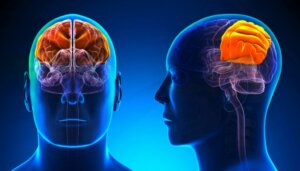Parietal Lobe: Characteristics and Functions

The human brain, which has a volume of approximately 1,350 and 1,500 cm³, is made up of 6 cerebral lobes (regions into which the brain is divided, each with a series of linked functions). One of these lobes is the parietal lobe, which is involved, above all, in the processes of integration of functions and information.
It is very interrelated with the rest of the lobes, and acts in conjunction with them. It’s one of the largest areas of association in the brain, and is involved in functions such as sensory integration and the processing of symbolic-analytical information.
What else do we know about this lobe? Where is it located and how does it work? What happens if it gets injured? Keep reading and find out more!
Parietal lobe: location and characteristics

The parietal lobe is one of the six human brain lobes, along with the temporal, occipital, frontal, insula and limbic lobes. It’s located under the cranial bone that gives it its name, between the frontal and occipital lobes.
More specifically, it’s located just behind the frontal lobe, and both lobes are separated by another structure, called the central sulcus.
Of all the lobes, it is one of the most important ones, due to its size and the functions in it carries out and is involved in. As we said before, the parietal lobe works in conjunction with the rest of the lobes of the brain.
Complete perceptual experience
This lobe integrates information from various sources. For example, it mixes information related to what we see and what we hear, and allows us to have a complete perceptual experience.
Memory and emotions
It’s also related to memory. In this way, the memories that are “stored” in the hippocampus remain fixed in the neural networks of the parietal lobe.
We know that these memories integrate all the sensory information from the outside world, but also the emotions and sensations linked to these memories. In the parietal lobe both perceptual and emotional processes converge (for example, the regulation of mood).
Features
The parietal lobe is involved in various functions, although we would like to highlight its fundamental role in three types of processes: the integration and processing of sensory information that comes from different sources, the processing of symbolic information (related to language), and the processing of numerical information.
Let’s have a more detailed look at the functions of this lobe:
Integrating sensory information
The parietal lobe has a fundamental role in the integration of information. This means that it plays a key role in unifying information from different sources. Thus, the result of such information is “a whole” that is more than “the sum of the parts” (hence the concept of integration).
Thanks to this lobe we’re able to have abstract concepts and ideas in our mind. To get an idea of what this means, let’s imagine the image of a cat. The parietal lobe allows us to have the idea of what a cat is in our heads, and to associate that cat with certain smells, touch, movements, sensations…
It places us in space
In addition to this, this lobe is involved in how we relate to the world around us in real time. For example, in this lobe, the information coming from the different muscles of the body is unified, which allows us to have an idea about our posture and our physical position in space.
Somesthetic processing
The same also happens with touch. The parietal lobe allows us to discover what we are touching and what sensations that touch produces, for example, what we call somesthetic processing – the sensory capacity to recognize bodily sensations.
Feedback from voluntary movements
Within the function of sensory integration, we also find the feedback that this lobe offers us about how our voluntary movements are doing. This feedback is possible thanks to the coordination of the parietal lobe with the frontal lobe.
But what is this useful for? To correct and modify our body movements in the event of obstacles or unforeseen events around us.
It allows us to recognize letters drawn on our skin
Finally, the parietal lobe also allows us to recognize letters and words that someone is drawing on our back or on the palm of the hand, for example (or on the skin in general). This curious ability is called graphesia.
Processing symbolic-analytical information
The parietal lobe is very involved with the symbolic functions of the brain, that is, those related to language, symbols, mathematics, abstract concepts…
Thanks to the fact that many mental processes are combined in this lobe, abstract thinking or reasoning is possible, allowing us to think by using symbols. The parietal lobe is located very centrally, allowing it to receive input from all parts of the brain.
This enables you to integrate information from different regions. Ultimately, thanks to this integration and the central position of the parietal lobe, we can obtain a global and integrated experience in our consciousness as a result of everything we experience.
What happens if the parietal lobe is injured?
Lesions in the parietal lobe cause different symptoms or dysfunctions. Normally, they involve alterations in body image and spatial relationships.
It can also cause language disorders, such as aphasia, as well as an inability to perceive objects (agnosia).
Lesions in the left parietal lobe: Gerstmann syndrome

Depending on the injured lobe (right or left), the symptoms are also diverse. More specifically, a lesion in the left parietal lobe can cause Gerstmann syndrome.
This syndrome, according to an article by Deus i Espert (1996), was first described by the neurologist Josef Gerstmann in 1924. Initially, Gerstmann described it as a neurological deficit secondary to a brain injury, characterized by the inability to recognize or identify the fingers of one’s own hand and those of another person.
At first, he called this symptomatology digital agnosia, but later he emphasized the frequent association of digital agnosia with other symptoms, such as right-left disorientation. So, we currently know that it is a syndrome that includes the following symptoms:
- Confusion regarding left and right
- Difficulties in writing (agraphia)
- Difficulty in mathematics (acalculia)
Right parietal lobe injury: hemispheric neglect, apraxia, and anosognosia
If a right parietal lobe injury occurs, the person may experience hemispheric neglect, resulting in an inability to recognize a certain part of the body or area. This causes difficulties in day-to-day tasks such as dressing, putting on makeup, washing etc.
On the other hand, lesions in the right parietal lobe can also cause constructive apraxia (with difficulties in drawing and organizing objects) and anosognosia (not being aware of deficiencies).
Curiosities of the parietal lobe
As with all brain lobes, we actually have two of them (one on each side of the brain or cerebral hemisphere). In the case of the parietal lobe, it’s more active in the left hemisphere in right-handed people,
On the other hand, in left-handed people, the right hemisphere is more active, which helps to interpret the images and to get to know the distance between them. However, regardless of whether we are left-handed or right-handed, we use both sides of the parietal lobe (although to a greater or lesser extent).
As we can see, the parietal lobe is a complex and interesting lobe that integrates information and that is interrelated with the rest of the lobes (which is why it’s considered an association zone).
It is linked to the processing of symbols, language and mathematics (after all, these last two concepts are symbols) and to the integration of information from different sources.
Its injury causes multiple symptoms and disorders, mainly related to the recognition of objects, the organization of the perceptual field, and the confusion of the letters, among others.
The human brain, which has a volume of approximately 1,350 and 1,500 cm³, is made up of 6 cerebral lobes (regions into which the brain is divided, each with a series of linked functions). One of these lobes is the parietal lobe, which is involved, above all, in the processes of integration of functions and information.
It is very interrelated with the rest of the lobes, and acts in conjunction with them. It’s one of the largest areas of association in the brain, and is involved in functions such as sensory integration and the processing of symbolic-analytical information.
What else do we know about this lobe? Where is it located and how does it work? What happens if it gets injured? Keep reading and find out more!
Parietal lobe: location and characteristics

The parietal lobe is one of the six human brain lobes, along with the temporal, occipital, frontal, insula and limbic lobes. It’s located under the cranial bone that gives it its name, between the frontal and occipital lobes.
More specifically, it’s located just behind the frontal lobe, and both lobes are separated by another structure, called the central sulcus.
Of all the lobes, it is one of the most important ones, due to its size and the functions in it carries out and is involved in. As we said before, the parietal lobe works in conjunction with the rest of the lobes of the brain.
Complete perceptual experience
This lobe integrates information from various sources. For example, it mixes information related to what we see and what we hear, and allows us to have a complete perceptual experience.
Memory and emotions
It’s also related to memory. In this way, the memories that are “stored” in the hippocampus remain fixed in the neural networks of the parietal lobe.
We know that these memories integrate all the sensory information from the outside world, but also the emotions and sensations linked to these memories. In the parietal lobe both perceptual and emotional processes converge (for example, the regulation of mood).
Features
The parietal lobe is involved in various functions, although we would like to highlight its fundamental role in three types of processes: the integration and processing of sensory information that comes from different sources, the processing of symbolic information (related to language), and the processing of numerical information.
Let’s have a more detailed look at the functions of this lobe:
Integrating sensory information
The parietal lobe has a fundamental role in the integration of information. This means that it plays a key role in unifying information from different sources. Thus, the result of such information is “a whole” that is more than “the sum of the parts” (hence the concept of integration).
Thanks to this lobe we’re able to have abstract concepts and ideas in our mind. To get an idea of what this means, let’s imagine the image of a cat. The parietal lobe allows us to have the idea of what a cat is in our heads, and to associate that cat with certain smells, touch, movements, sensations…
It places us in space
In addition to this, this lobe is involved in how we relate to the world around us in real time. For example, in this lobe, the information coming from the different muscles of the body is unified, which allows us to have an idea about our posture and our physical position in space.
Somesthetic processing
The same also happens with touch. The parietal lobe allows us to discover what we are touching and what sensations that touch produces, for example, what we call somesthetic processing – the sensory capacity to recognize bodily sensations.
Feedback from voluntary movements
Within the function of sensory integration, we also find the feedback that this lobe offers us about how our voluntary movements are doing. This feedback is possible thanks to the coordination of the parietal lobe with the frontal lobe.
But what is this useful for? To correct and modify our body movements in the event of obstacles or unforeseen events around us.
It allows us to recognize letters drawn on our skin
Finally, the parietal lobe also allows us to recognize letters and words that someone is drawing on our back or on the palm of the hand, for example (or on the skin in general). This curious ability is called graphesia.
Processing symbolic-analytical information
The parietal lobe is very involved with the symbolic functions of the brain, that is, those related to language, symbols, mathematics, abstract concepts…
Thanks to the fact that many mental processes are combined in this lobe, abstract thinking or reasoning is possible, allowing us to think by using symbols. The parietal lobe is located very centrally, allowing it to receive input from all parts of the brain.
This enables you to integrate information from different regions. Ultimately, thanks to this integration and the central position of the parietal lobe, we can obtain a global and integrated experience in our consciousness as a result of everything we experience.
What happens if the parietal lobe is injured?
Lesions in the parietal lobe cause different symptoms or dysfunctions. Normally, they involve alterations in body image and spatial relationships.
It can also cause language disorders, such as aphasia, as well as an inability to perceive objects (agnosia).
Lesions in the left parietal lobe: Gerstmann syndrome

Depending on the injured lobe (right or left), the symptoms are also diverse. More specifically, a lesion in the left parietal lobe can cause Gerstmann syndrome.
This syndrome, according to an article by Deus i Espert (1996), was first described by the neurologist Josef Gerstmann in 1924. Initially, Gerstmann described it as a neurological deficit secondary to a brain injury, characterized by the inability to recognize or identify the fingers of one’s own hand and those of another person.
At first, he called this symptomatology digital agnosia, but later he emphasized the frequent association of digital agnosia with other symptoms, such as right-left disorientation. So, we currently know that it is a syndrome that includes the following symptoms:
- Confusion regarding left and right
- Difficulties in writing (agraphia)
- Difficulty in mathematics (acalculia)
Right parietal lobe injury: hemispheric neglect, apraxia, and anosognosia
If a right parietal lobe injury occurs, the person may experience hemispheric neglect, resulting in an inability to recognize a certain part of the body or area. This causes difficulties in day-to-day tasks such as dressing, putting on makeup, washing etc.
On the other hand, lesions in the right parietal lobe can also cause constructive apraxia (with difficulties in drawing and organizing objects) and anosognosia (not being aware of deficiencies).
Curiosities of the parietal lobe
As with all brain lobes, we actually have two of them (one on each side of the brain or cerebral hemisphere). In the case of the parietal lobe, it’s more active in the left hemisphere in right-handed people,
On the other hand, in left-handed people, the right hemisphere is more active, which helps to interpret the images and to get to know the distance between them. However, regardless of whether we are left-handed or right-handed, we use both sides of the parietal lobe (although to a greater or lesser extent).
As we can see, the parietal lobe is a complex and interesting lobe that integrates information and that is interrelated with the rest of the lobes (which is why it’s considered an association zone).
It is linked to the processing of symbols, language and mathematics (after all, these last two concepts are symbols) and to the integration of information from different sources.
Its injury causes multiple symptoms and disorders, mainly related to the recognition of objects, the organization of the perceptual field, and the confusion of the letters, among others.
- Deus, J. y Espert, R. (1996). Síndrome de Gerstmann: perspectiva actual. Psicología Conductual, 4(3): 417-436.
- Greene, J.D.W. (2005). Apraxia, agnosias and higher visual function abnormalities. Journal of Neurology, Neurosurgery & Psychiatry; 76:v25-v34
- Guyton, A.C. (1994) Anatomía y fisiología del sistema nervioso. Neurociencia básica. Madrid: Editorial Médica Panamericana.
- Nolte, J. (1994) El cerebro humano: introducción a la anatomía funcional. Madrid: Mosby-Doyma.
- Paulsen F., Waschke J. (2018). Sobotta. Atlas de anatomía humana. 3: Cabeza, cuello y neuroanatomía. Elsevier Health Sciences.
Este texto se ofrece únicamente con propósitos informativos y no reemplaza la consulta con un profesional. Ante dudas, consulta a tu especialista.







